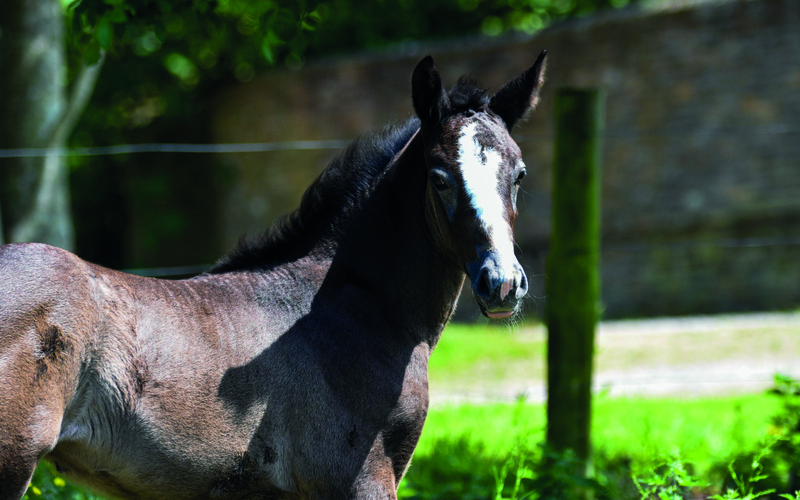
Raising the bar for British breeding
“We want to raise the bar on the quality of horses being bred in Britain. To do that, we need to be breeding from the best mares,” says Edward Matson of Twemlows Stud Farm in Shropshire, one of the UK’s leading Artificial Insemination and Embryo Transfer centres. Edward and his family have been championing British breeding for many years and they are passionate about the latest technologies.
“Artificial Insemination (AI) is the most common of the assisted reproductive technologies,” says Edward. “It’s what most studs will do as it is easier for the mares and gives a far greater choice of stallions.” During AI, semen collected from the stallion is inseminated into the uterus of the mare by a qualified technician or vet. While it can be more expensive than natural cover, it is safer for both the mare and stallion, with lower risk of injury or transmission of disease. Semen can be fresh, chilled or frozen, giving owners the freedom to use a wide range of stallions from the UK and worldwide.
Leading on from AI is Embryo Transfer (ET). ET enables an embryo to be carried throughout the pregnancy by a recipient (surrogate) mare, leaving the genetic mother free to continue her competition career. With this process the donor mare is ‘flushed’ eight days after the AI or covering has taken place and an embryo is hopefully collected and prepared for transfer into the recipient mare. It can also be useful for mares that are unable to carry their own foals and to give owners the option to breed more than one foal per year.
The cost will vary depending on success and this can be influenced by the age of mares and fertility of the stallion. Edward advises that with competition mares, timing and planning are invaluable. “Ask yourself: what’s my competition schedule? Where is my mare in her cycle? If you are thinking of using ET for your mare, you want to make sure that firstly, the type of semen you require is readily available from your chosen stallion and secondly, you’ve got access to a good supply of recipients. The donor and recipient need to be at the same point in their cycle. With a competition mare, you only have a ery small window of opportunity, so we advise having back-up options for both recipient mares and stallion choices.”
Trisha Rickards has been through the process several times, having used it for her British-bred 5* mares – Classic Moet, who won the Twemlows Scholarship, and Faerie Dianimo. “Thirty or forty years ago when I started breeding, you just got your mare in foal,” she says. “Either you paused the mare’s competition career, or you put them in foal when they were three, so they were ready to start their career at five. I think we’re all very lucky that science has moved on so rapidly and produced these amazing things we can do with our mares.”
The latest techniques
As science continues to progress, new technologies enter the mix and Ovum Pick Up (OPU) and Intra-Cytoplasmic Sperm Injection (ICSI) are becoming increasingly popular. Similar to human IVF, OPU is the collection of eggs (oocytes) directly from the mare’s follicles in her ovary to be taken to the laboratory. ICSI is the technique used for fertilisation of the oocytes, where one sperm cell is injected into each mature oocyte. Following this procedure an embryo may develop and can then be frozen and stored. The average number of frozen embryos achieved is two, but Twemlows have seen up to eight.
Oocytes need to be sent to specialist laboratories for ICSI, with Avantea in Italy considered one of the best places in Europe. The costs for this technology are high, but so are the benefits. The process can be done outside the normal breeding season, causing little or no interruption to competition work. Frozen embryos can be transferred to a recipient mare, stored until a later date or sold when the owner desires. It is ideal for mares unable to produce an embryo or unable to carry a pregnancy to term, and the requirement of a very small amount of semen allows sub-fertile stallions or exclusive/expensive semen to be used more effectively.
Marietta Fox-Pitt’s hugely popular National Hunt mare, Snow Leopardess, caught attention for producing a Thoroughbred foal during an injury break in her racing career. What is perhaps less widely known, however, is that she also has two foals on the ground by leading show jumping stallion Chacco-Blue. These potential eventers were foaled from recipient mares in spring 2023 following OPU and ICSI processes.
“We want to encourage people not to wait until their mare has retired or is no longer ridden,” concludes Edward. “With modern techniques, if you think a mare is good enough, you can start much younger without impacting on the mare’s competition career.”
Twemlows scholarship
For more than a decade, Twemlows Stud Farm has offered two ETs to the highest placed British bred or domiciled mare competing at Burghley Horse Trials. The first winner was Headley Britannia, who had two foals by Jaguar Mail from recipient mares in 2008, which was the successful British stallion, Britannia’s Mail. Since then, the scholarship has brought many of British eventing’s top mares through the doors of Twemlows, including Little Tiger, Kings Temptress, Briarlands Matilda, Vanir Kamira, and the 2023 winner, Cavalier Crystal.
“Vanir Kamira has been to us three times,” says Edward. “For people to see a mare like her still be at the very top of her game but with lots of offspring coming through, it has hopefully encouraged others to think about breeding. We did the Burghley scholarship because we wanted to encourage people to breed from the best British mares and show that it was possible.”
Trisha Rickards’ mare, Classic Moet, won the scholarship in 2015 and 2016. “I think it opened up a marvellous way to keep your horses in competition and still breed from them while they are still pretty much at their peak,” she says of the scholarship. “To win a prize that gives you the opportunity to see how ET works for free is just amazing. The two foals that it produced are now both out Novice eventing and hopefully will go on well.”
Trisha Rickards’ mare, Classic Moet, won the scholarship in 2015 and 2016. “I think it opened up a marvellous way to keep your horses in competition and still breed from them while they are still pretty much at their peak,” she says of the scholarship. “To win a prize that gives you the opportunity to see how ET works for free is just amazing. The two foals that it produced are now both out Novice eventing and hopefully will go on well.”
